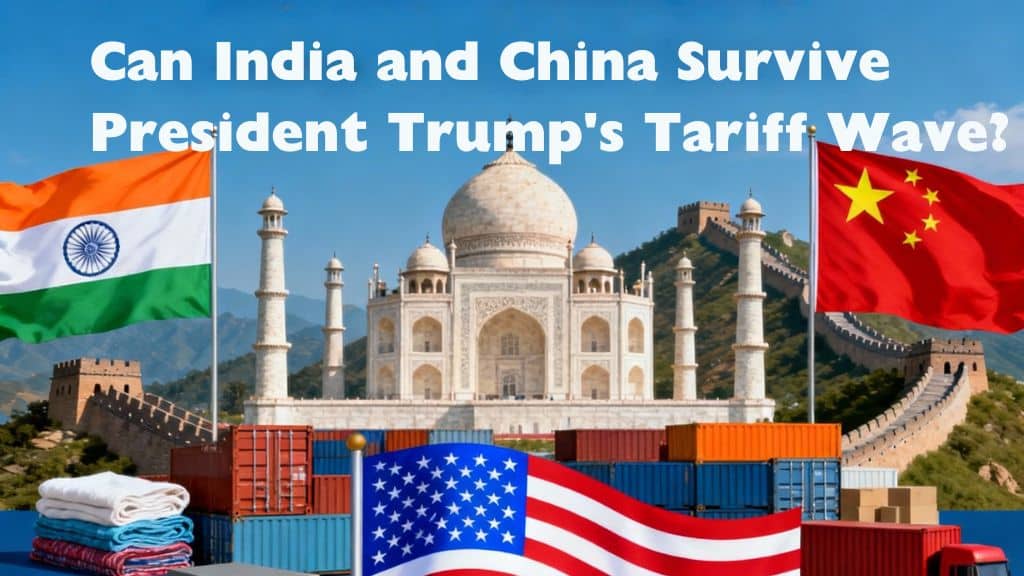President Trump’s aggressive new wave of US tariffs on imports from India and China has sent shockwaves across global markets. With rates reaching up to 50% on key products and ongoing threats of “secondary tariffs,” exporters in both nations face disruption in trade dynamics, job losses, and redefined supply chains. What does this future hold for the world’s two fastest-growing economies?
Main Impact Areas
India: Sectors Hardest Hit
- Garments, textiles, gems/jewelry, and footwear face steep tariff rates, threatening jobs and export revenue.
- Small manufacturers are most vulnerable, likely to lose US market share to competitors in Vietnam, Bangladesh, and other Asian economies.
- Some sectors like pharmaceuticals (mainly generics) remain temporarily exempt but fear wider future inclusion.
China: Strategic Responses
- China is negotiating more aggressively, seeking tariff advantages from Washington.
- Chinese exporters have redirected some goods to Europe, sometimes undercutting Indian suppliers and squeezing India’s market share abroad.
- Technology, electronics, and low-cost manufactured goods remain strong, though penalty tariffs threaten further escalation.
Supply Chain Ripple Effects
- The global supply chain faces stress as US buyers seek alternatives, and Asian exporters compete for shrinking market share.
- Domestic reform and diversification of markets are now a priority for both countries, with India in particular working to join new trade blocs.
- Policies promoting self-reliance have gained sudden urgency as international negotiations stall and protectionism rises worldwide.
Strategic Moves & The Road Ahead
- India and China must pursue aggressive trade reform, bilateral deals, and innovation to remain competitive under high US tariff regimes.
- Political ties between the USA and both countries are strained, with India shifting some focus towards Russia, China, and BRICS partnerships.
- The economic impact will depend on how quickly alternative markets, domestic reforms, and technological advancement can cushion the blow and support export recovery.
How Panoramic Sourcing Can Participate
Panoramic Sourcing, an experienced India-based sourcing company specializing in handcrafted items, leather goods, home furnishings, and fashion accessories, is strategically positioned to help exporters navigate the complex tariff environment.
- Shift to India Sourcing: Many US importers are shifting their sourcing from China to India due to rising tariffs. Panoramic Sourcing can connect global buyers with reliable, compliant Indian manufacturers offering competitive pricing and high-quality products.
- Compliance & Quality Control: Panoramic ensures that all suppliers are socially audited and comply with certifications such as BSCI and Sedex, helping to meet international market standards despite tariff challenges.
- Product Development & Innovation: With an in-house dedicated design team, Panoramic supports continuous product innovation tailored to changing market demands, helping Indian exporters maintain a competitive edge.
- Logistics Support: Panoramic offers end-to-end support from sourcing to logistics, ensuring smooth entry into tariff-affected markets with streamlined delivery and cost controls.
- Diverse Product Range: By focusing on high-demand categories like leather accessories, home décor, and handicrafts, Panoramic helps clients capitalize on tariff exemptions and niche market opportunities.
Through these strategic strengths, Panoramic Sourcing serves as a critical partner for international businesses seeking to mitigate the impact of tariffs and leverage India’s growing export potential.
Conclusion
India and China face formidable challenges under President Trump’s new tariff wave. While both nations possess resilient economies, swift policy action, strategic international alliances, and export innovation will determine long-term survival and success. Companies like Panoramic Sourcing play a vital role in helping businesses adapt by offering reliable sourcing solutions, quality control, and innovative product development. For exporters and manufacturers, adapting to this new reality is not optional—it’s the only way forward.
FAQ
Q1: Which Indian industries will be most affected by US tariffs?
A: Apparel, textiles, jewelry, seafood, leather goods, and labor-intensive sectors are most exposed, with potentially steep decline in exports and jobs.
Q2: Will China be hit harder than India by the new tariffs?
A: Chinese exporters face redirected US demand, leading to excess supply in Europe and competition with India. China’s more proactive negotiations may secure lower tariffs in select categories.
Q3: Are any Indian sectors exempt from tariffs?
A: Pharmaceuticals (mainly generic drugs) currently enjoy exemptions due to critical US demand, but future policy changes could alter this status.
Q4: What can exporters do to mitigate risks?
A: Diversifying export markets, investing in product quality, pursuing trade deals outside the US, and adopting technology-driven reforms are key strategies for resilience.
Q5: How will this affect global supply chains?
A: Sourcing patterns may shift, with the US looking beyond both China and India for alternatives. This could lead to opportunities for other Asian economies and global recalibration in trade flows.
Q6: How can Panoramic Sourcing help businesses impacted by tariffs?
A: Panoramic Sourcing connects buyers with vetted, compliant Indian suppliers, offers product development support, ensures quality and logistics management, enabling smooth trade despite tariff hurdles.

